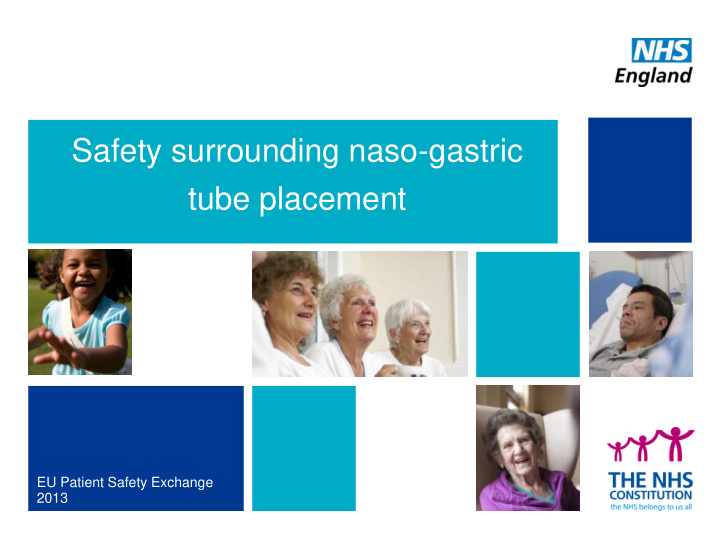



Safety surrounding naso-gastric tube placement EU Patient Safety Exchange 2013
2
Starting at the beginning………. • Original Alert – Medicines and Healthcare Regulatory Agency (MHRA) - June 2004 • Do not use blue litmus paper for checking nasogastric tube placement • Use pH indicator paper/strips covering the appropriate range • Define expected pH range for secretions to be tested such as gastric and bronchial secretions 3
National Patient Safety Agency - 2005 • Patient Safety Alert – February 2005 • Reducing the harm caused by misplaced nasogastric feeding tubes • The NPSA aware of 11 deaths and one case of serious harm due to misplaced nasogastric feeding tubes over a two-year period. • Patient Safety Alert – September 2009 • Reducing the harm caused by misplaced naso and orogastric feeding tubes in babies under the care of neonatal units 4
The following methods MUST NOT be used: • Auscultation of air insufflated through the feeding tube (‘whoosh’ test ) • Testing acidity/alkalinity of aspirate using blue litmus paper • Interpreting absence of respiratory distress as an indicator of correct positioning • Monitoring bubbling at the end of the tube • Observing the appearance of feeding tube aspirate 5
The following SHOULD be done: • Carry out individual risk assessment prior to nasogastric tube feeding • Prior to feeding each patient, a risk assessment needs to be carried out by a competent person. A decision needs to be made that balances the risks with the need to feed. • Review and agree local action required • Changing and improving clinical practice in relation to nasogastric feeding tube placement will require a local programme to facilitate change: - availability of pH paper - staff and carer training - interpretation of x-rays - tube design 6
Key message • measuring the pH of aspirate using pH indicator strips/paper is recommended; • radiography is recommended but should not be used ‘routinely 7
National Patient Safety Agency - 2009 • Never Event • Misplaced naso- or oro-gastric tubes • Death or severe harm due to a misplaced naso- or oro-gastric tube being used where the misplacement of the tube is not detected prior to commencement of feeding, flush or medication administration. Never events reported to the NRLS and SHAs in 2010/11 and 2011/12 = 80 8
National Patient Safety Agency - 2011 • Patient Safety Alert – March 2011 • Reducing the harm caused by misplaced nasogastric feeding tubes in adults, children and infants • This Alert updated and strengthened Patient Safety Alert 05 (Reducing the harm caused by misplaced nasogastric feeding tubes) • NRLS received a further 21 deaths and 79 cases of feeding into the lung since Sept 2005 9
Key message • Main causal factor leading to harm was misinterpretation of x-rays • Found in 45 incidents, 12 of which resulted in the death of the patient • The Alert does not change the advice given in Patient Safety Alert 05 that pH testing remains the first line test, and x-ray checking remains the second line test. 10
11
National Patient Safety Agency - 2012 • Rapid Response Report – March 2012 • Harm from flushing of nasogastric tubes before confirmation of placement • 2 patient deaths since 10 March 2011 where staff had flushed nasogastric tubes with water before initial placement had been confirmed. 12
Compliance with current guidance Sir Liam Donaldson Patient Safety Envoy for the World Health Organisation “NPSA guidance is not being heeded” • Feeding despite an aspirate with pH between 6 & 8 • Instilling water down the tube before checking tube placement • Not recording written confirmation of such checks 13
“Many practitioners may have not considered the potential for harm that these innocent-looking plastic tubes may present, particularly if they are misplaced in the patient’s oesophagus or, worse, a bronchus” Williams & McDavid (2012) Casebook 14
In conclusion ……… The answers are no longer to giving more guidance we need a ‘new way’ 15
Recommend
More recommend